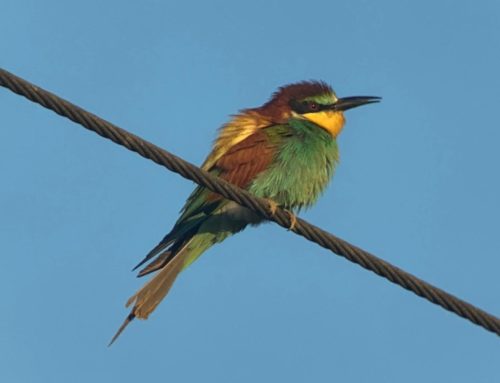A review of Breeding Bee-eaters in Britain
Last year, 2023, was the first time that European Bee-eaters nested at two locations in the UK, and also the first time that a breeding site was reoccupied in consecutive years. In the June issue of British Birds (www.britishbirds.co.uk) a paper by Mark Thomas and myself looks at the breeding history of Bee-eaters in the UK and for the first time gives details of how many of the breeding sites were protected by the RSPB and how where possible the sites were opened to allow public viewing.

One of the Bee-eaters that bred at Trimingham, Norfolk, in 2022 (RSPB)
Background
The Bee-eater is only an occasional breeder in the UK and since the first recorded nesting in Scotland in 1920, there have only been 11 documented instances of breeding. That first attempt failed following the death of the female. A second attempt, however, was successful: in 1955 three pairs settled at a Sand Martin colony in Sussex and two of these pairs fledged seven young between them. The remaining nine attempts have all occurred this century, the next being in 2002 at Bishop Middleham in Co. Durham –the first where RSPB were involved. Since then the following counties have had pairs at least attempting to breed: Cumbria, Dorset, Greater Manchester, Herefordshire, Isle of Wight, Norfolk (twice), Nottinghamshire and Yorkshire. Only the attempts in Co. Durham (2002, 2 young fledged), Isle of Wight (2014, two pairs, nine young fledged), Cumbria (2015, two pairs, one young fledged) and Norfolk (2022, two pairs, two young fledged) have been successful. Full details of all the breeding records and the protection measures employed are given in the paper (BB 117: 318-328, June 2024).

Trimingham signage (RSPB)
Safeguarding the nesting sites
The RSPB first set up specific watches on sites where Bee-eaters were breeding in 2002, when a pair nested in a disused quarry at Bishop Middleham in Co. Durham. A courting pair of Bee-eaters found by an RSPB Investigations Officer led to that officer setting up guard himself until a more permanent safeguarding team could be put in place. A car park and viewing point were set up and visitors were asked to sign in in the hope that egg-collectors would be deterred or detected. Once the eggs had hatched more publicity was put in place; in the end around 15,000 people visited the site.
Subsequent breeding attempts were dealt with in similar ways; the last being Trimingham in Norfolk in 2022 and 2023. Four chicks fledged in 2022 and for the first time ever in Britain, birds returned in 2023, though the nesting pair failed at the incubation stage. Also, uniquely in the history of nesting Bee-eaters in Britain, a second site was occupied in the same year, this time in Greater Manchester. However, that pair failed after chicks hatched when the site was abandoned, perhaps due to the burrow collapsing or predation.
At the time of writing, we are not aware of any Bee-eaters settling at potential breeding sites this year, but the cold, wet spring and early summer are unlikely to have encouraged this species to breed.
Why the increase?
Reporting of the annual minimum number of Bee-eaters in Britain firstly by the British Birds Rarities Committee and then, as the species became commoner, in the Scarce Migrants report also published in British Birds, shows a clear and consistent increase, particularly over the last 40 years (fig. 1), though there is much annual variation. Since the start of the century, only four years have recorded over 100 birds: 2002 (104 birds), 2015 (193), 2021 (133) and 2022 (130). Breeding in Britain occurred in all but one of these years, but there is not a direct relationship between high migrant numbers and breeding. For instance, migrant numbers were low in 2005 and 2006, yet breeding attempts occurred.

Fig. 1. Annual totals of European Bee-eaters Merops apiaster in Britain, 1958-2022.
What is clear though is that the European breeding range has been expanding northwards, clearly shown by the change map in the second European Bird Atlas (Keller et al. 2021; fig. 2). Climate change is thought to have led to this, through increased temperatures and duration of sunshine leading to more aerial insect food being available.

Fig. 2. Change in distribution of breeding pairs European Bee-eaters Merops apiaster in Europe between the first European Bird Atlas (EBBA1, 1980s) and the second (EBBA2, 2013–2017).

Visitors enjoying the Bee-eaters breeding at Trimingham, Norfolk (RSPB)
Future of breeding Bee-eaters in Britain
It is likely that breeding in Britain will become more frequent and that multiple breeding occurrences per year will be more likely. All colonising species, but especially attractive and conspicuous ones like the Bee-eater, are nevertheless vulnerable to human interference and disturbance or predation. The paper concludes that without proper protection and wardening, breeding attempts may well fail and colonisation would probably falter. Projects to protect and to show the birds to the public are recognised to have a large conservation benefit in widening the appreciation of nature.
If you are lucky enough to discover breeding Bee-eaters, or Bee-eaters in suitable habitat during the breeding season, please think carefully about to whom the sighting is report, and please let RSPB Investigations know. More information on what to do when rare breeding birds are found is available on the RBBP website at https://rbbp.org.uk/if-i-find-a-rbbp-species-breeding/.



